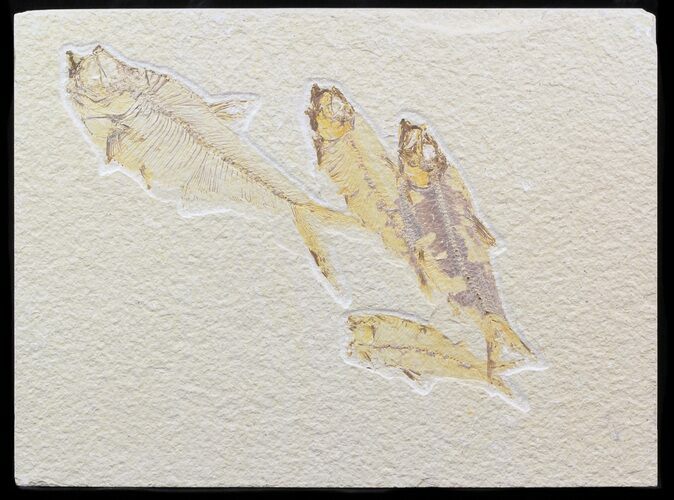This Specimen has been sold.
Diplomystus & Knightia Fossil Fish Plate - 8.7"x6.4"
This 8.7"x6.4" slab of shale from the Green River Formation which contains fossil fish of two different species, the largest being 5" This specimen was collected from Warfield's Quarry near Kemmerer, Wyoming. Comes with a display stand.
About Knightia
Knightia is an extinct genus of small, schooling, ray-finned fish related to modern herrings and sardines. Abundant in the warm freshwater lakes of the Eocene Green River Formation, they fed on insects, plankton, and tiny fish, while serving as prey for nearly every larger predator in the ecosystem. The most common species, Knightia eocena, reached about 15 cm in length and is celebrated today as the state fossil of Wyoming.
These streamlined fish are recognized by their heavy scales, small conical teeth, and rows of dorsal and ventral scutes along the body. Their fossils are among the most iconic from the Green River Formation—an exceptional 48-million-year-old lake deposit in Wyoming, Colorado, and Utah known for preserving a remarkably detailed snapshot of ancient life in a warm, lake-rich Eocene landscape.
Knightia is an extinct genus of small, schooling, ray-finned fish related to modern herrings and sardines. Abundant in the warm freshwater lakes of the Eocene Green River Formation, they fed on insects, plankton, and tiny fish, while serving as prey for nearly every larger predator in the ecosystem. The most common species, Knightia eocena, reached about 15 cm in length and is celebrated today as the state fossil of Wyoming.
These streamlined fish are recognized by their heavy scales, small conical teeth, and rows of dorsal and ventral scutes along the body. Their fossils are among the most iconic from the Green River Formation—an exceptional 48-million-year-old lake deposit in Wyoming, Colorado, and Utah known for preserving a remarkably detailed snapshot of ancient life in a warm, lake-rich Eocene landscape.
SPECIES
Diplomystus dentatus & Knightia eocaena
LOCATION
Fossil Safari Quarry, Kemmerer, Wyoming
FORMATION
Green River Formation
SIZE
Plate 8.7"x6.4", Largest fish 5"
CATEGORY
SUB CATEGORY
ITEM
#42498
We guarantee the authenticity of all of our specimens.
 Reviews
Reviews












